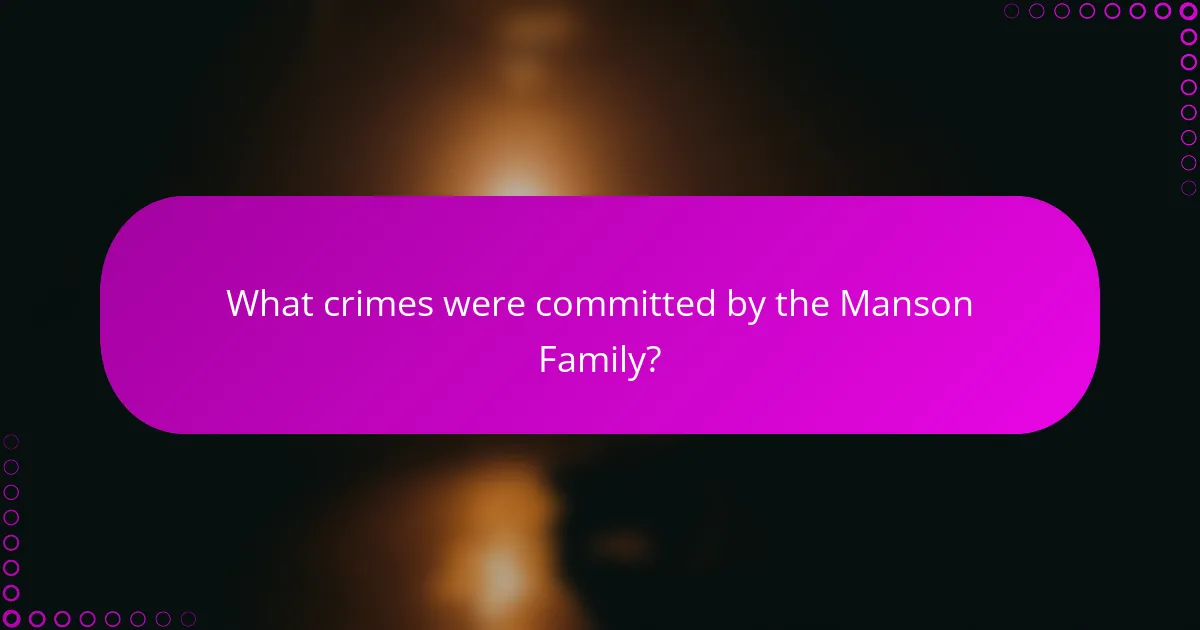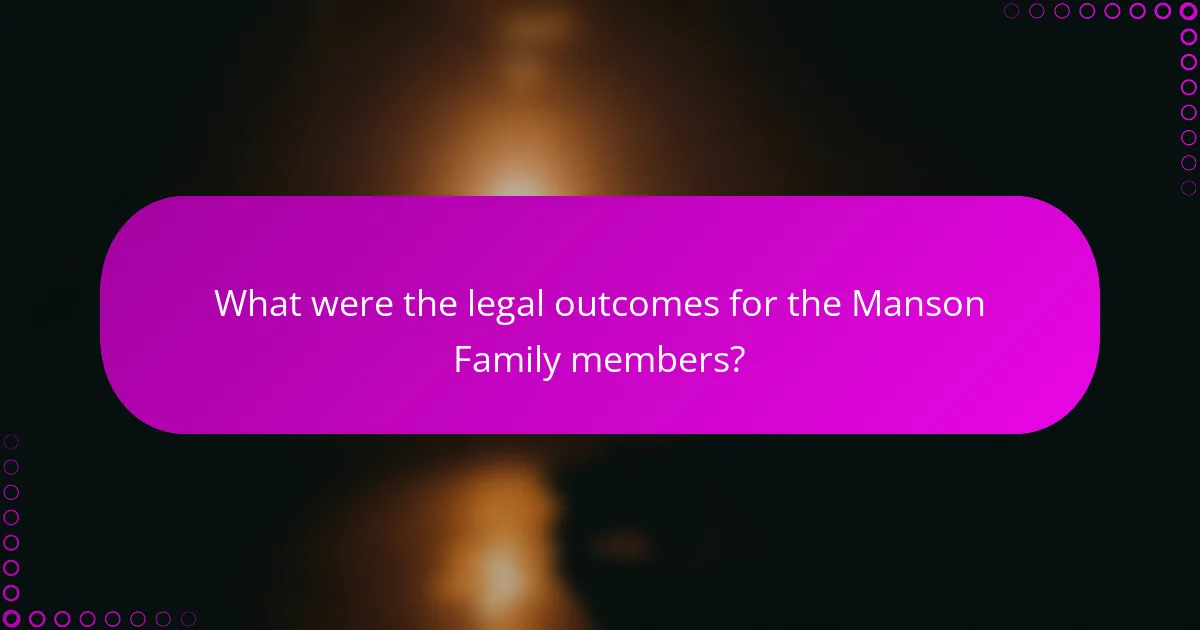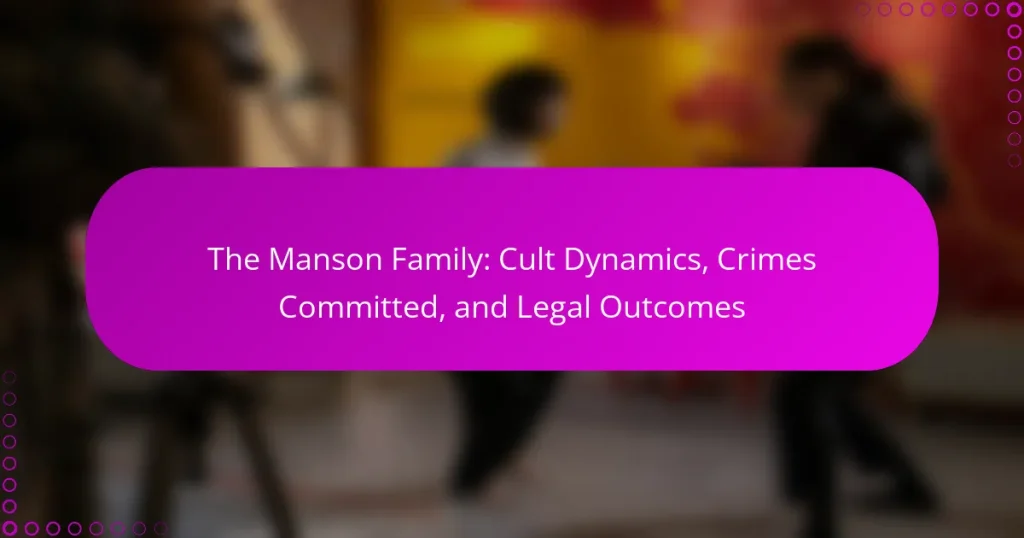The Manson Family was a cult led by Charles Manson in the late 1960s, notorious for a series of brutal murders in California, most infamously the Tate-LaBianca murders in August 1969. Manson orchestrated these killings, driven by his belief in an impending apocalyptic race war he termed “Helter Skelter.” Following the crimes, law enforcement arrested many members of the family, leading to multiple convictions for murder and conspiracy. Charles Manson himself was sentenced to life in prison, where he remained until his death in 2017, and several of his followers also received life sentences. The shocking nature of these crimes highlighted the dangers of cult influence and generated significant media attention and public outrage.

What is the Manson Family?
The Manson Family was a cult led by Charles Manson in the late 1960s. This group gained notoriety for committing a series of brutal murders in California. The most infamous crime was the Tate-LaBianca murders in August 1969. Manson believed in an impending apocalyptic race war, which he called “Helter Skelter.” Members of the family carried out the murders under his influence and direction. Law enforcement arrested many members in 1969. Charles Manson was convicted of first-degree murder and conspiracy to commit murder. He was sentenced to life in prison, where he remained until his death in 2017.
How did the Manson Family form?
The Manson Family formed in the late 1960s under the leadership of Charles Manson. Manson attracted followers through his charisma and teachings, which combined elements of counterculture, [censured], and apocalyptic beliefs. He initially gathered a group of young individuals who were disillusioned with society. These followers were drawn to his vision of a coming race war, which he termed “Helter Skelter.” The group lived communally in California, engaging in various illegal activities. Manson’s influence over his followers grew as he manipulated their emotions and beliefs. This dynamic led to the infamous crimes committed by the group in 1969, including the Tate-LaBianca murders. The formation and subsequent actions of the Manson Family exemplified the dangers of cult dynamics and manipulation.
What were the key events leading to the establishment of the Manson Family?
The Manson Family was established through a series of pivotal events. Charles Manson, a failed musician, sought to create a commune in the late 1960s. He attracted followers, primarily young women, with his charisma and radical ideology. Manson’s teachings combined elements of [censured], apocalyptic beliefs, and a fascination with The Beatles. In 1968, he formed the Manson Family in California, promoting a lifestyle centered around free love and communal living. The group became increasingly isolated from society, engaging in criminal activities. Manson’s influence over his followers deepened, leading to the infamous Tate-LaBianca murders in 1969. These events marked the culmination of Manson’s control and the establishment of the Manson Family as a notorious cult.
Who were the primary figures in the Manson Family?
The primary figures in the Manson Family included Charles Manson, Susan Atkins, Patricia Krenwinkel, and Leslie Van Houten. Charles Manson was the leader who orchestrated the group’s criminal activities. Susan Atkins was involved in the Tate-LaBianca murders. Patricia Krenwinkel participated in the same murders and was a key member of the group. Leslie Van Houten was also implicated in the LaBianca killings. These individuals were central to the Manson Family’s notoriety and subsequent legal proceedings. Their actions led to significant media coverage and public outrage during the late 1960s.
What beliefs and ideologies did the Manson Family promote?
The Manson Family promoted a blend of apocalyptic beliefs and a philosophy centered on chaos. They believed in an impending race war, which Charles Manson termed “Helter Skelter.” This ideology was influenced by Manson’s interpretation of the Beatles’ music and the social upheaval of the 1960s. The group also embraced a form of communal living, rejecting societal norms and advocating for a lifestyle free from conventional constraints. Manson positioned himself as a messianic figure, claiming to be the voice of a new spiritual awakening. The Family practiced mind control techniques to maintain loyalty and obedience among its members. Their beliefs led to violent actions, including the infamous Tate-LaBianca murders in 1969. These crimes were intended to incite the race war Manson envisioned.
How did Charles Manson influence the group’s ideology?
Charles Manson significantly influenced the group’s ideology by promoting a belief in an impending apocalyptic race war. He used manipulation and psychological control to instill loyalty among his followers. Manson preached that they were the chosen ones who would survive this chaos. He combined elements of [censured], Eastern philosophy, and his own ideas to create a unique doctrine. His teachings emphasized love, peace, and rebellion against societal norms, which attracted disillusioned youth. Manson’s charismatic leadership and persuasive rhetoric solidified his control over the group. He also used music and communal living to reinforce his ideology and foster a sense of belonging. This blend of ideology and manipulation led to the tragic actions committed by the Manson Family.
What role did music and culture play in the Manson Family’s beliefs?
Music and culture significantly influenced the Manson Family’s beliefs. Charles Manson used music as a tool for manipulation and indoctrination. He believed that the Beatles’ song “Helter Skelter” predicted an apocalyptic race war. This interpretation fueled the group’s ideology and actions. Manson also encouraged members to create their own music, fostering a sense of community and shared purpose. The counterculture of the 1960s provided a backdrop for their beliefs, appealing to themes of rebellion and alternative lifestyles. This cultural context made Manson’s ideas resonate with disaffected youth. The blending of music and culture helped solidify the group’s identity and commitment to Manson’s vision.

What crimes were committed by the Manson Family?
The Manson Family committed several high-profile crimes, most notably the Tate-LaBianca murders in 1969. They killed actress Sharon Tate and four others on August 8, 1969. The following night, they murdered Leno and Rosemary LaBianca. These killings were part of a larger plan orchestrated by Charles Manson. Manson aimed to incite a race war, which he referred to as “Helter Skelter.” Members of the Manson Family were later convicted for their roles in these murders. The crimes shocked the nation and highlighted the dangers of cult influence. The trials led to significant media coverage and public outrage.
What were the most notorious crimes linked to the Manson Family?
The most notorious crimes linked to the Manson Family include the Tate-LaBianca murders. On August 8-9, 1969, members of the Manson Family brutally killed actress Sharon Tate and four others at her home. This crime shocked the nation and garnered extensive media coverage. The following night, Manson’s followers murdered Leno and Rosemary LaBianca in their home. The killings were part of Manson’s plan to incite a race war, which he termed “Helter Skelter.” The Manson Family’s actions led to multiple arrests and trials. In 1971, Charles Manson and several followers were convicted of first-degree murder. These crimes remain some of the most infamous in American history.
How did the Tate-LaBianca murders unfold?
The Tate-LaBianca murders unfolded over two nights in August 1969. On August 8, members of the Manson Family attacked the home of actress Sharon Tate. They killed Tate, who was eight months pregnant, and four others present. The next night, on August 9, they targeted the LaBianca home. They murdered Leno and Rosemary LaBianca in a brutal fashion. Both incidents were orchestrated by Charles Manson to incite a race war. The murders shocked the nation and led to a massive police investigation. Ultimately, several Manson Family members were arrested and convicted for their roles in the killings.
What other criminal activities were associated with the Manson Family?
The Manson Family was associated with various criminal activities beyond the infamous murders. They engaged in theft and burglary, often stealing from homes in the Los Angeles area. Additionally, members were involved in drug offenses, including the distribution of illegal substances. The group also participated in acts of vandalism and violence against individuals who opposed them. These activities contributed to their notoriety and legal troubles. The Manson Family’s criminal behavior stemmed from their cult dynamics and extreme ideology.
What was the impact of the Manson Family’s crimes on society?
The impact of the Manson Family’s crimes on society was profound and far-reaching. The brutal murders committed in 1969 shocked the nation. This led to heightened fears about cults and societal unrest. Public perception of the counterculture movement shifted dramatically. Many viewed it as a threat rather than a liberation. Media coverage intensified scrutiny on alternative lifestyles and communal living. The trials of Manson and his followers captivated the public’s attention. This resulted in a significant cultural response, influencing films, literature, and art. The crimes also prompted discussions about mental health and the influence of charismatic leaders. Overall, the Manson Family’s actions left a lasting mark on American society and culture.
How did the media portray the Manson Family’s actions?
The media portrayed the Manson Family’s actions as shocking and sensational. Reports highlighted the brutal nature of their crimes, particularly the Tate-LaBianca murders in 1969. Coverage often emphasized the cult-like behavior of Charles Manson and his followers. The narrative depicted them as emblematic of societal fears during the late 1960s. Media outlets focused on the gruesome details, which captivated public attention. Television and print journalism contributed to a perception of the Manson Family as a symbol of moral decay. The portrayal sparked widespread discussions about violence and counterculture in America. This intense media scrutiny influenced public opinion and legal proceedings surrounding the case.
What societal changes were prompted by the Manson Family’s crimes?
The Manson Family’s crimes prompted significant societal changes, particularly in perceptions of cults and personal safety. The brutal murders in 1969 shocked the nation and led to increased media scrutiny of cult activities. Law enforcement agencies began to recognize the potential dangers posed by cults, resulting in new training programs. The crimes also sparked discussions about mental health and the influence of charismatic leaders. Additionally, there was a rise in public interest in true crime, shaping media portrayals of violence. These events contributed to changes in legislation regarding cults and enhanced awareness of their psychological tactics. Overall, the Manson Family’s actions had a lasting impact on societal attitudes toward crime and safety.

What were the legal outcomes for the Manson Family members?
The legal outcomes for the Manson Family members included multiple convictions for murder and conspiracy. Charles Manson was sentenced to life in prison for orchestrating the Tate-LaBianca murders in 1969. Several of his followers received similar sentences for their roles in these crimes. Notably, Susan Atkins, Patricia Krenwinkel, and Leslie Van Houten were convicted and sentenced to life imprisonment. Over the years, some members sought parole but were consistently denied. Manson himself died in prison in 2017, serving a life sentence without the possibility of parole.
What charges were brought against Charles Manson and his followers?
Charles Manson and his followers were charged with first-degree murder and conspiracy to commit murder. These charges stemmed from the infamous Tate-LaBianca murders in 1969. Manson was accused of orchestrating the killings, while his followers carried out the acts. The prosecution argued that Manson’s influence and control over the group led to the brutal slayings. Ultimately, Manson was convicted and sentenced to life in prison. His followers received varying sentences, with some also receiving life sentences for their roles in the crimes.
How did the legal proceedings against the Manson Family unfold?
The legal proceedings against the Manson Family began with the arrests of several members in 1969. They were charged with the murders of seven people, including actress Sharon Tate. The trial commenced in 1970 and gained significant media attention. Charles Manson and several followers were convicted of first-degree murder and conspiracy. Manson received a death sentence, which was later commuted to life imprisonment. The trial revealed the cult’s influence and the psychological manipulation involved. Appeals were made but ultimately upheld the convictions. The legal outcomes set a precedent for future cult-related cases.
What were the sentences given to key members of the Manson Family?
Charles Manson was sentenced to life imprisonment for conspiracy to commit murder. He was convicted in 1971 for orchestrating the Tate-LaBianca murders. Susan Atkins received a life sentence for her role in the murders. Leslie Van Houten was also sentenced to life imprisonment for her involvement. Patricia Krenwinkel received a life sentence as well. Tex Watson was sentenced to life imprisonment for his part in the crimes. These sentences reflect their roles in the infamous events of 1969. The convictions were upheld after multiple appeals.
How did the legal outcomes affect public perception of cults?
Legal outcomes significantly influenced public perception of cults. High-profile trials, like that of the Manson Family, exposed the dangers associated with cults. Media coverage of these trials heightened awareness and fear about cult activities. The prosecution of cult leaders reinforced the idea that cults could be harmful and manipulative. Public discussions about mental health and manipulation arose from these legal cases. Consequently, many viewed cults with suspicion and concern. This shift in perception led to increased scrutiny of unconventional religious groups. Overall, legal outcomes shaped a more cautious societal attitude toward cults.
What lessons were learned from the Manson Family case regarding cult dynamics?
The Manson Family case highlighted critical lessons about cult dynamics. It demonstrated the power of charismatic leaders in manipulating followers. Charles Manson exploited psychological vulnerabilities to gain control over his followers. The case showed how isolation from society can enhance a cult’s influence. Members were often subjected to intense indoctrination and peer pressure. The events revealed the dangers of extreme loyalty to a leader. Additionally, it underscored the importance of understanding groupthink in cult behavior. The Manson Family’s violent actions illustrated the potential for cults to incite criminal behavior. These lessons remain relevant in analyzing modern cults and their dynamics.
How have legal responses to cults evolved since the Manson Family trials?
Legal responses to cults have significantly evolved since the Manson Family trials. Following these trials in the late 1960s, law enforcement and legal frameworks began to recognize the unique challenges posed by cults. The Manson Family’s violent actions highlighted the need for better monitoring of such groups. Consequently, laws were enacted to address issues like coercion and abuse within cults.
In the 1970s and 1980s, states implemented stricter regulations on group activities. Legal definitions of cult-related crimes expanded to include psychological manipulation and human trafficking. The establishment of organizations like the Cult Awareness Network in the 1980s provided resources for victims and families.
Additionally, court cases began to set precedents regarding the rights of former members. Legal scholars and lawmakers started advocating for protective measures against coercive persuasion techniques. These developments reflect a growing recognition of the dangers posed by cults, leading to more proactive legal responses.
What resources are available for understanding the Manson Family’s legacy?
Books, documentaries, and academic articles are available for understanding the Manson Family’s legacy. Notable books include “Helter Skelter” by Vincent Bugliosi, which details the crimes and trials. Documentaries such as “Manson: The Lost Tapes” provide visual insights into the cult’s dynamics. Academic articles analyze the psychological aspects of the Manson Family, exploring their influence on popular culture. Additionally, online resources like the FBI’s files on Charles Manson offer primary source material for research. These resources collectively provide a comprehensive view of the Manson Family’s impact on society and culture.
Where can one find books and documentaries about the Manson Family?
Books and documentaries about the Manson Family can be found at public libraries, online retailers, and streaming services. Major online platforms like Amazon offer a wide selection of books. Documentaries are available on platforms such as Netflix and Hulu. Many bookstores also stock titles related to the Manson Family. Academic libraries may have specialized resources on the topic. Additionally, websites like IMDb list documentaries and films about the Manson Family. These sources provide various perspectives on the cult dynamics, crimes, and legal outcomes associated with the Manson Family.
What are some common misconceptions about the Manson Family and their crimes?
A common misconception about the Manson Family is that they were purely a mindless cult. In reality, many members were drawn to the group for a sense of community and belonging. Another misconception is that Charles Manson directly ordered all the murders. Evidence shows that he influenced but did not always explicitly command his followers to kill. Additionally, some believe the crimes were random acts of violence. The murders were planned and targeted, particularly the Tate-LaBianca killings in 1969. Many also think the Manson Family had a large number of members. At its peak, the group had around 100 followers, not the thousands often suggested. Lastly, there’s a belief that the Manson Family was entirely composed of women. While women played significant roles, many male members were also involved in the crimes.
The Manson Family was a cult led by Charles Manson in the late 1960s, notorious for a series of brutal murders, including the Tate-LaBianca killings. The article explores the formation of the Manson Family, key figures involved, and the ideologies that fueled their violent actions. It details the significant crimes committed, the legal proceedings that followed, and the societal impact of their actions, including shifts in public perception of cults. Additionally, it addresses common misconceptions about the Manson Family and provides resources for further understanding their legacy.


